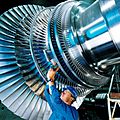Torsion (mechanics) facts for kids
Torsion is all about twisting! Imagine you're wringing out a wet towel. When you twist it, you're creating torsion. In science, torsion is the twisting of an object. This twisting happens when a special kind of force, called a torque, is applied to it.
When you twist something that is round, like a metal rod, the twisting force creates stress inside the object. This stress is called "shearing stress." It acts sideways, trying to pull the material apart in a twisting motion. The further away from the center of the object you are, the stronger this twisting stress becomes.
Contents
What is Torsion?
Torsion is the way an object twists when a turning force is applied to it. Think of it like turning a doorknob or using a screwdriver. You are applying a twisting force, which causes torsion in the doorknob's mechanism or the screwdriver's shaft.
This twisting force is called torque. Torque makes things rotate or twist. When an object experiences torsion, it means it's being twisted around its length.
How Does Torsion Work?
When you twist an object, different parts of it move slightly. The outside of the object twists more than the inside. This difference in twisting creates internal forces within the material. These forces are called "shear stress." They are like tiny pushes and pulls that happen sideways, trying to resist the twisting motion.
Imagine a long, straight stick. If you twist one end while holding the other, the stick will twist along its length. The amount it twists depends on:
- How strong the twisting force (torque) is.
- How long the object is.
- What the object is made of (some materials twist more easily than others).
- The shape and size of the object.
Measuring Torsion
Scientists and engineers often need to measure how much an object twists or how much stress it can handle before breaking. They use special formulas to figure this out.
One important measurement is the "angle of twist." This tells you how many degrees or radians an object twists along its length. For example, a long, thin rod will twist more than a short, thick one, even with the same twisting force.
Another important idea is the "shear modulus." This is a number that tells you how stiff a material is when you try to twist it. Materials with a high shear modulus are very stiff and don't twist much, like steel. Materials with a low shear modulus twist easily, like rubber.
Engineers also consider something called the "polar moment of inertia." This sounds complicated, but it basically describes how resistant a cross-section of an object is to twisting. A thicker, rounder shaft is much harder to twist than a thin one.
Why is Torsion Important?
Torsion is a very important concept in many areas of engineering and daily life:
- Cars and Machines: The axles in cars, the drive shafts in machines, and even the crankshafts in engines all experience torsion. They need to be designed to handle these twisting forces without breaking.
- Tools: Screwdrivers, wrenches, and drills rely on torsion to work. The handles and bits must be strong enough to transfer the twisting force.
- Bridges and Buildings: While less obvious, some parts of structures can experience twisting forces, especially during strong winds or earthquakes. Engineers must design them to resist these forces.
- Everyday Objects: From twisting a bottle cap to wringing out a mop, torsion is happening all around us!
Understanding torsion helps engineers design safer and stronger objects, from tiny gears to huge bridges.
Related pages
Images for kids
-
The rotor of a modern steam turbine
See also
 In Spanish: Torsión mecánica para niños
In Spanish: Torsión mecánica para niños




